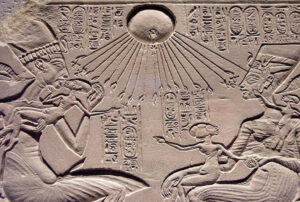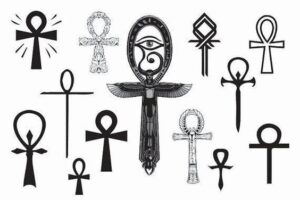Table of Contents
Who Is Atum?
Atum is a deity in ancient Egyptian religion, representing the complete and self-created god. In Egyptian mythology, Atum is often considered the first god, associated with creation and the sun. Atum is sometimes depicted as a man wearing a crown and sometimes as a serpent, emphasizing the dual aspects of his creative powers. He is a part of the Ennead, a group of nine deities in Egyptian mythology, and is particularly linked to the city of Heliopolis. Atum is credited with creating himself and then bringing forth the gods Shu and Tefnut, who, in turn, gave rise to other deities and the world. Atum’s significance lies in his role as the self-generating and creative force in the Egyptian cosmogony.
Origin

The origin of Atum as a deity in ancient Egyptian mythology is deeply rooted in the creation myths of Heliopolis, a significant religious center in ancient Egypt. Atum is a part of the Ennead, a group of nine deities representing the essential aspects of the Egyptian pantheon.
According to the Heliopolitan creation myth, Atum is considered the self-created deity, emerging from the primordial waters known as Nun. Atum is often described as a solitary and self-sufficient god who brings himself into existence. In some versions of the myth, Atum is depicted as a serpent, symbolizing the primal life force and the cyclical nature of creation.
Atum’s creative act involved masturbation or spitting, and from this act, Atum generated two deities: Shu, the god of air, and Tefnut, the goddess of moisture. Shu and Tefnut, in turn, gave rise to other deities, forming the divine family that played a central role in the Egyptian cosmogony.
The origin of Atum as the self-created and self-generating god signifies the Egyptian understanding of the divine creative force and the cyclical nature of creation, reflecting the fundamental principles of the ancient Egyptian worldview.
Family of Atum
In Egyptian mythology, Atum is associated with the Ennead, a group of nine deities worshipped primarily in the city of Heliopolis. Atum is considered the primeval god and a self-created deity. Here is an overview of Atum’s family within the Ennead:
Shu (Air): Shu is the god of air and one of the offspring of Atum. Shu is often depicted as a person standing on the earth, holding up the sky, which emphasizes his role in separating the earth (Geb) from the sky (Nut).
Tefnut (Moisture): Tefnut is the goddess of moisture and is another child of Atum. She is often depicted as a lioness or as a woman with the head of a lioness.
From the union of Shu and Tefnut, the Ennead further expands:
Geb (Earth): Geb is the god of the earth and is the son of Shu and Tefnut. He is often depicted as a man lying on the ground.
Nut (Sky): Nut is the goddess of the sky and is also a child of Shu and Tefnut. She is often depicted as a woman arched over the earth, her body representing the sky.
The children of Geb and Nut are:
Osiris: Osiris is a major deity associated with death, resurrection, and the afterlife.
Isis: Isis is a powerful goddess known for her magic and maternal qualities.
Set (Seth): Set is a deity associated with chaos, storms, and the desert.
Nephthys: Nephthys is a goddess associated with mourning, death, and protection.
The Ennead represents a divine family tree that played a significant role in Egyptian cosmology and mythology. Atum, as the self-created god, serves as the progenitor of this divine lineage, with subsequent generations of deities shaping various aspects of the Egyptian pantheon.
Symbolic Influence

The symbolic influence of Atum in ancient Egyptian mythology is profound and encompasses several key aspects:
Creation and Self-Creation: Atum’s act of self-creation from the primordial waters symbolizes the inherent creative power within the divine. This act sets the stage for the entire process of creation in Egyptian cosmogony.
Primal Life Force: Atum’s association with a serpent in some depictions emphasizes the primal life force inherent in creation. The serpent, a symbol of regeneration and cyclical renewal, underscores the eternal nature of the divine.
Unity and Oneness: Atum’s self-sufficiency and the subsequent creation of Shu and Tefnut highlight the concept of unity and oneness within the divine. Atum’s role as the progenitor reflects the interconnectedness of all aspects of existence.
Cosmic Order: Atum’s descendants, including Shu, Tefnut, Geb, Nut, Osiris, Isis, Set, and Nephthys, represent various elements of the cosmos. Their interactions and relationships establish the cosmic order, with each deity contributing to the balance and harmony of the universe.
Creative Catalyst: Atum serves as the creative catalyst, initiating the process that leads to the formation of the Ennead and, subsequently, the entire Egyptian pantheon. This emphasizes the role of Atum as the prime mover in the divine hierarchy.
Cyclical Nature of Creation: Atum’s act of self-creation and the subsequent generation of deities underscore the cyclical nature of creation, death, and rebirth. This cyclical aspect aligns with Egyptian beliefs in the eternal recurrence of life and the afterlife.
Divine Generations: Atum’s family tree, including the Ennead, represents successive generations of deities, each contributing to the order and functioning of the cosmos. The family dynamic within the Ennead illustrates the interconnected relationships that sustain the divine order.
Atum’s symbolic influence is intricately woven into the fabric of Egyptian cosmology, conveying essential concepts of creation, unity, and cyclical renewal that shaped the religious beliefs and cultural worldview of ancient Egypt.
Modern Influence

The modern influence of Atum is relatively limited in comparison to other ancient Egyptian deities. However, aspects of ancient Egyptian mythology, including figures like Atum, have inspired creative works, artistic expressions, and symbolic interpretations in contemporary culture. Here are a few ways in which the influence of Atum can be observed:
Art and Literature: Atum, along with other Egyptian deities, has inspired artists and writers. Contemporary art and literature may draw on the symbolism and mythology associated with Atum, integrating these themes into modern creative expressions.
Symbolic Interpretations: The symbolism of Atum, representing creation, self-generation, and the cyclical nature of existence, can be explored in symbolic or philosophical contexts. Some individuals may find inspiration in these ancient concepts for personal or spiritual reflection.
Pop Culture References: Elements of Egyptian mythology, including Atum, occasionally appear in popular culture. This can include references in movies, video games, literature, and other forms of entertainment where ancient myths are adapted or reimagined.
Spiritual Practices: Some individuals with an interest in ancient Egyptian spirituality or modern eclectic spiritual practices may incorporate symbols or concepts associated with Atum into their rituals or belief systems.
Educational and Museum Outreach: Institutions dedicated to Egyptology and ancient history play a role in maintaining awareness of deities like Atum. Educational programs, museum exhibits, and scholarly publications contribute to public knowledge and interest in ancient Egyptian mythology.
While the direct influence of Atum in the modern world is not as pronounced as in ancient times, the enduring fascination with Egyptian mythology ensures that elements of Atum’s symbolism and narrative continue to resonate in various cultural and educational contexts.
Atum FAQ
Who is Atum?
Atum is a deity in ancient Egyptian mythology, associated with creation and the solar aspect of divinity. Atum is often considered a self-created god and a primeval force in Egyptian cosmogony.
What is Atum the god of?
Atum is associated with creation, specifically the act of self-creation, and is often regarded as the progenitor of the Egyptian gods. Atum is also linked to the sun and is considered a solar deity.
How did Atum create the universe?
In Egyptian mythology, Atum is said to have created the universe through an act of self-generation. Atum emerged from the primordial waters, representing the initial state of chaos, and from this self-creation, the process of divine generation began.
What does Atum mean?
The name "Atum" is thought to be derived from the Egyptian word "tm," which means "complete" or "perfection." The name reflects Atum's role as a self-sufficient and self-created deity.
How did Atum create the Egyptian gods?
Atum is said to have created the Egyptian gods through a process of self-generation. The act of self-creation resulted in the formation of Shu (god of air) and Tefnut (goddess of moisture), who, in turn, gave rise to other deities in the Egyptian pantheon.
Who created Atum?
In Egyptian mythology, there isn't a specific creator for Atum. Atum is often considered self-created, emerging from the primordial waters at the dawn of creation.
Is Atum the same as Ra?
Atum and Ra are distinct deities in Egyptian mythology, but they share solar attributes. Atum is associated with the setting sun, while Ra is associated with the sun at its zenith. In some traditions, Atum and Ra are syncretized or considered different aspects of the same solar deity.
Why does Atum cry?
The idea of Atum crying is not a prominent motif in Egyptian mythology. However, some myths involve the eye of Atum shedding tears, symbolizing the creation of humankind. These tears were sometimes considered as the source of the Nile River.
What is the spirit of Atum?
In Egyptian mythology, Atum embodies the spirit of self-creation and completeness. The concept of Atum represents the divine force that brings itself into existence, symbolizing the eternal and self-sustaining nature of the divine.
Why did Atum remove his eye?
The removal of the eye is often associated with the Eye of Ra, which can represent various aspects, including the destructive and protective powers of the sun. It's not a common motif for Atum specifically to remove his eye.
What gender is Atum?
Atum is often depicted as a male deity. The androgynous or gender-fluid aspects are more commonly associated with other Egyptian deities, like Atum's children Shu and Tefnut.




